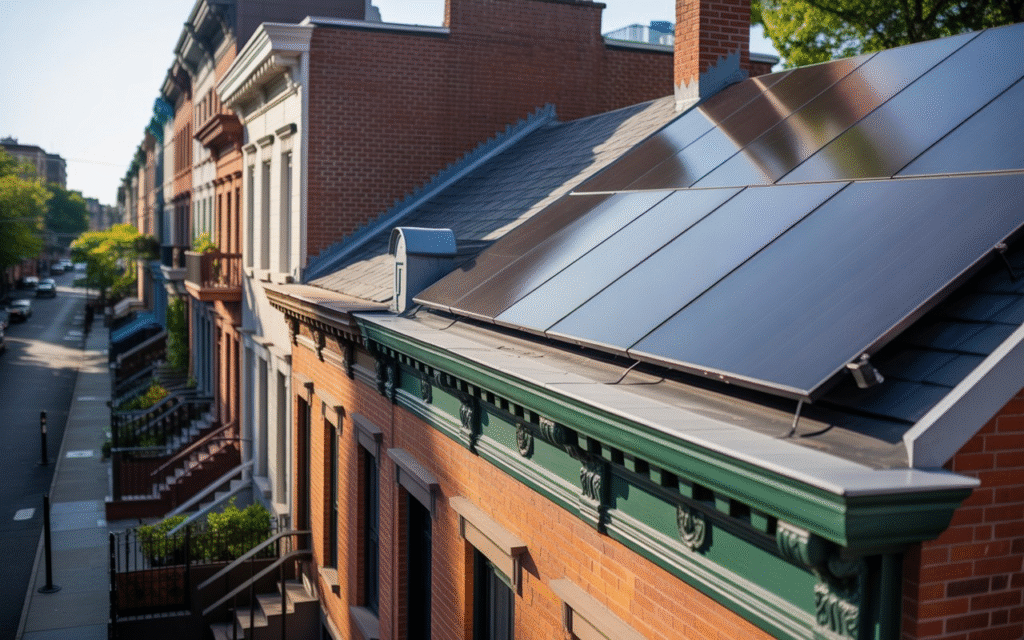Going Green in Historic Neighborhoods: Solar Solutions for Older Buildings
Historic neighborhoods are filled with charm. From detailed cornices to original brickwork, every building tells a story about the people and time periods that shaped it. For homeowners in these areas, making the switch to renewable energy often comes with a tough question: how do you add modern solar panels to a century-old roof without compromising its beauty or breaking local preservation rules?

At New York Electric and Solar, we’ve seen firsthand that it’s possible to bring clean energy to older buildings without losing their character. It’s all about smart design, specialized installation techniques, and a respect for the unique qualities of each property.
Understanding the Challenge
Many older buildings in New York were not built with solar power in mind. Rooflines may be steep or irregular, materials can be fragile, and there are often strict historic preservation guidelines that dictate what changes are allowed.
Adding to the challenge, wiring and electrical systems in older homes can be outdated. Before a panel is ever installed, it’s important to evaluate whether the existing infrastructure can support modern solar technology. This step ensures safety and efficiency, while also preventing costly surprises later in the project.
Working with Local Regulations
One of the biggest hurdles for solar installation in historic districts is navigating local rules and preservation codes. Many municipalities have strict guidelines designed to protect the visual character of historic neighborhoods.
The good news is that these guidelines do not necessarily block solar adoption. They do, however, require a thoughtful approach. Installers must be familiar with the local permitting process and willing to work closely with preservation boards. This means submitting detailed plans, providing visual mockups, and explaining how the panels will integrate into the existing structure without disrupting its historic appeal.
Design Solutions for Blending Old and New
The key to success in these projects is design. Panels don’t have to be an eyesore. There are several strategies that allow solar technology to blend seamlessly with older architecture.
Low-Profile Panels: Using panels that sit close to the roof surface can minimize their visibility from the street. These are particularly useful on flat or gently sloped roofs.
Color Coordination: Panels and mounting equipment can be selected in colors that complement existing roof materials. Darker panels often blend well with slate or asphalt shingles.
Strategic Placement: Placing panels on roof sections that are less visible from the street helps preserve the building’s historic look. In some cases, panels can even be mounted on secondary structures like garages or outbuildings.
Retrofitting Older Roofs
Older roofs often need reinforcement before they can support the weight of a solar array. This might involve replacing worn materials, repairing structural damage, or upgrading flashing and weatherproofing.
In some cases, the installation process itself must be adapted to protect fragile materials. For example, working on a slate roof requires specialized tools and techniques to avoid cracking tiles. This is where experience matters. Installers who have worked on historic properties understand how to handle these materials with care.
Hidden Benefits for Historic Homes
One of the less obvious advantages of adding solar to a historic property is the potential for other energy-saving improvements. Many solar upgrades are paired with efficiency measures like better insulation, updated wiring, and modernized heating systems.
Older homes often have higher energy bills due to drafts, outdated appliances, and less efficient heating. Combining solar with other energy upgrades can lead to dramatic savings. In some cases, homeowners have been able to cut their utility costs by half while maintaining their home’s historic charm.
Success Stories from the Field
In one project, a brownstone in a New York historic district needed solar panels but had a highly visible roofline. The solution was to install a low-profile array on the rear section of the roof, completely hidden from the street. The panels provided enough power to meet most of the household’s needs without altering the building’s appearance.
In another case, a century-old farmhouse had a roof made from original cedar shakes. Before the panels could be installed, the roof was carefully restored using matching materials. The solar array was then mounted in a way that preserved the roofline’s original look while delivering reliable energy year-round.
Community and Environmental Impact
Historic districts are often close-knit communities where homeowners take pride in their neighborhood’s character. When one property successfully adds solar without affecting its appearance, it can inspire others to explore similar upgrades.
By making solar accessible for historic homes, these neighborhoods can reduce their collective carbon footprint without losing the qualities that make them special. Over time, this shift not only benefits the environment but also enhances the appeal of the area for future generations.
Choosing the Right Partner
Installing solar on a historic building is not a job for just any contractor. It requires a team that understands both the technical aspects of solar power and the preservation of historic architecture.
New York Electric and Solar has experience working in these challenging environments. Our team knows how to navigate local regulations, design discreet solutions, and handle older building materials with care. We work closely with homeowners and preservation boards to create systems that look right and perform well.
The Path Forward for Historic Homes
As more communities embrace renewable energy, historic neighborhoods will face the challenge of adapting without losing their unique identity. The good news is that the technology and expertise now exist to make this possible.
With the right planning, a respect for local history, and a commitment to quality installation, it’s possible for even the oldest buildings to step into a greener future. Solar energy is not just for new construction—it can be a smart, sustainable choice for historic homes too.
By combining careful design with modern efficiency, we can keep these beloved neighborhoods beautiful while helping them lead the way in clean energy adoption.
